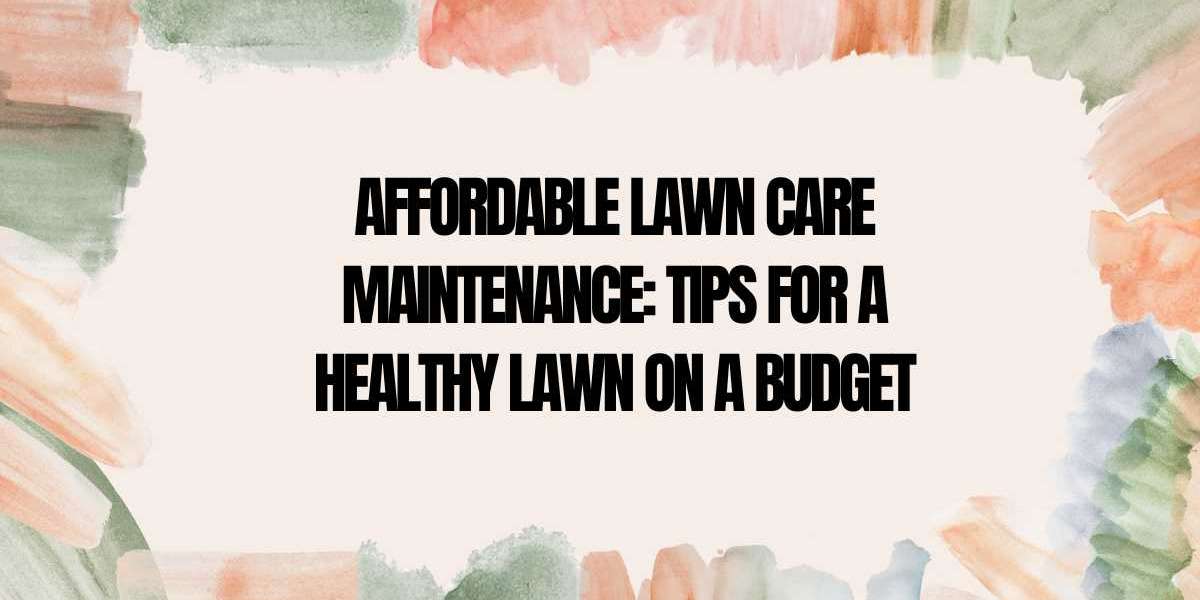Affordable Lawn Care Maintenance: A Guide to Keeping Your Yard Healthy on a Budget
A well-maintained lawn is the pride of any homeowner. It enhances curb appeal, creates a relaxing outdoor space, and contributes to the overall aesthetics of your property. However, maintaining a beautiful lawn can sometimes seem like a daunting and expensive task. Many people assume that keeping their lawn healthy requires costly services or frequent treatments, but that doesn’t have to be the case. With affordable lawn care maintenance strategies, you can have a lush, green yard without breaking the bank. Affordable lawn care maintenance ensures a healthy, vibrant yard without the high costs.
In this guide, we’ll explore various aspects of affordable lawn care maintenance, including essential tips, cost-saving practices, and how to manage your lawn’s health while staying within budget. Additionally, we’ll answer some common questions related to affordable lawn care.
Understanding Lawn Care Maintenance
Lawn care maintenance involves the routine tasks necessary to keep your lawn in optimal condition. This includes mowing, fertilizing, watering, aerating, and controlling weeds and pests. Each of these activities plays a role in keeping your lawn healthy and green.
The key to affordable lawn care is to approach these tasks systematically and regularly. If you neglect lawn maintenance, you may end up facing costly repairs, such as reseeding bare patches, dealing with pests, or correcting soil imbalances. By addressing issues early and maintaining a regular routine, you can avoid many expensive problems.
1. Mowing: A Simple but Effective Task
Mowing is one of the most basic yet essential tasks for lawn care maintenance. Not only does it keep your lawn looking neat, but it also encourages healthy growth. However, improper mowing can damage your grass, leading to higher costs down the road.
Affordable Mowing Tips:
- Mow High: Set your mower to cut your grass at a higher setting. Taller grass shades the soil, which helps prevent weed growth and conserves moisture.
- Mow When Dry: Wet grass clumps together, making it harder to mow. It also leads to uneven cutting. Mowing when the grass is dry will result in a cleaner, healthier cut.
- Sharpen Your Blades: Dull blades can rip grass, leaving it susceptible to diseases. Sharpen your mower blades regularly to keep them effective.
2. Fertilizing: Feed Your Lawn Without Overdoing It
Fertilizing your lawn is essential for promoting strong growth, but it can get expensive if done improperly. Over-fertilizing not only wastes money but can also harm the environment.
Affordable Fertilizing Tips:
- Use Organic Fertilizers: Organic options, such as compost or natural fertilizers, are often less expensive and better for your lawn’s long-term health.
- Follow a Schedule: Over-fertilizing can lead to unhealthy grass. Instead, use fertilizers according to your lawn’s needs and schedule, typically in the spring and fall.
- Test Your Soil: Before applying fertilizer, test your soil to identify deficiencies. This allows you to apply the right nutrients and avoid unnecessary expenses.
3. Watering: The Right Balance
Watering your lawn is critical for maintaining its health, but it’s essential to do so efficiently. Overwatering wastes water and money, while underwatering stresses the grass.
Affordable Watering Tips:
- Water Deeply and Infrequently: It’s more efficient to water your lawn deeply once a week than to water lightly every day. This encourages the grass roots to grow deeper, making your lawn more drought-resistant.
- Water Early or Late: Watering in the early morning or late afternoon reduces evaporation, saving water and money.
- Use a Sprinkler System: If you don’t have one already, investing in a sprinkler system with a timer can help you control water usage more effectively and prevent overwatering.
4. Aerating: Boosting Root Health
Aeration is the process of perforating your lawn with small holes to allow air, water, and nutrients to reach the roots more effectively. While it’s not necessary to aerate every year, doing it every couple of years can help improve lawn health.
Affordable Aerating Tips:
- DIY Aeration: Renting an aerator can be much cheaper than hiring a professional service. Aerate your lawn in the fall when the grass is actively growing.
- Choose the Right Time: Aerate during the growing season, typically in late spring or early fall, to get the best results.
- Overseed After Aeration: After aerating, overseed your lawn to promote new growth and fill in any thinning areas.
5. Weed and Pest Control: Prevention Is Key
Weeds and pests are common problems that can make lawn care seem more expensive than it is. While chemical treatments are available, they can be costly and harmful to the environment.
Affordable Weed and Pest Control Tips:
- Mulch Your Lawn: Mulch helps prevent weeds by blocking sunlight. It’s a simple and inexpensive way to maintain a healthy lawn.
- Spot Treatment: Instead of using broad-spectrum pesticides, treat only the affected areas. This prevents unnecessary spending and protects beneficial insects.
- Use Natural Weed Killers: Consider using homemade solutions, like vinegar or boiling water, to kill weeds in flower beds or on your lawn’s edge.
6. Lawn Disease Prevention: Stay Ahead of Problems
Lawn diseases can spread quickly if left untreated. Identifying and addressing them early can save you time and money. Look for common signs of lawn diseases, such as brown patches, mold, or excessive thatch.
Affordable Disease Prevention Tips:
- Maintain Proper Drainage: Waterlogged soil is a breeding ground for disease. Ensure your lawn has good drainage to avoid water buildup.
- Use Disease-Resistant Grass Varieties: Some grass species are naturally resistant to diseases. If you’re replanting, choose varieties that are less likely to get sick.
7. Seasonal Lawn Care
Seasonal changes play a significant role in how your lawn grows and reacts to maintenance practices. Adjust your lawn care routine according to the season to maximize results.
Affordable Seasonal Tips:
- Spring: Apply fertilizer, overseed thin spots, and begin mowing regularly.
- Summer: Water deeply, mow high, and control pests.
- Fall: Aerate your lawn, fertilize with a slow-release product, and prepare for winter.
- Winter: Limit foot traffic on your lawn and avoid heavy watering.
Frequently Asked Questions (FAQs) about Affordable Lawn Care Maintenance
Q1: How often should I mow my lawn?
A: Mowing frequency depends on the growth rate of your grass, but generally, you should mow once a week during the growing season. Adjust the frequency based on weather conditions and grass type.
Q2: Can I fertilize my lawn myself to save money?
A: Yes, you can fertilize your lawn yourself. In fact, many homeowners find that applying fertilizer themselves is more affordable than hiring a professional. Just ensure you follow recommended schedules and apply the right type of fertilizer for your soil.
Q3: How do I know if my lawn needs aeration?
A: If your lawn feels spongy or compacted, or if water doesn’t absorb properly, it may be time to aerate. Generally, lawns should be aerated every 1-2 years, depending on traffic and soil conditions.
Q4: What’s the best way to control weeds without spending a lot?
A: Using mulch, pulling weeds by hand, and applying homemade weed solutions like vinegar can help control weeds affordably. Avoid costly chemical herbicides unless absolutely necessary.
Q5: What should I do if I have patches of dead grass?
A: If you notice dead patches, first check for the cause, such as disease, pests, or watering issues. Then, reseed the affected areas or use sod to fill in bare spots. Regular maintenance can prevent future issues.
Conclusion
Affordable lawn care maintenance doesn’t have to be a daunting or expensive task. By following these tips and adopting a DIY approach, you can keep your lawn healthy and attractive without overspending. Regular mowing, proper watering, fertilizing, aerating, and pest control are essential components of a cost-effective lawn care routine. With a little time and effort, your lawn can thrive year-round while staying within your budget.
By being proactive and consistent, you’ll ensure your lawn remains a beautiful, green oasis for years to come.






